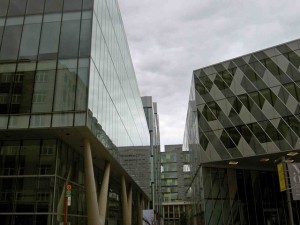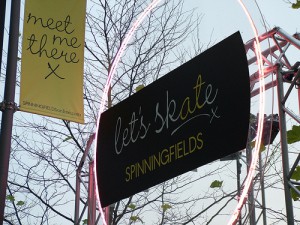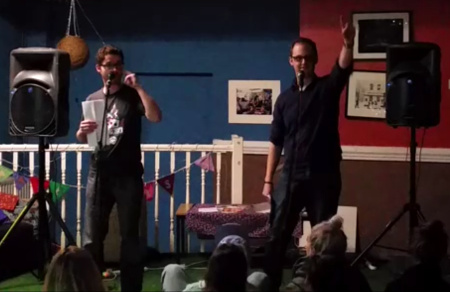Victoria Park and the gated urban community
Article published: Friday, June 3rd 2011
The 2011 Victoria Park Festival is in full swing, but few now know of the area’s historical significance as Manchester’s first gated community. Andy Northcott explains.
 Throughout May and June a series of events are being held as part of the Victoria Park Festival 2011. Centred around St Chrysostom’s Church, the festival will take in inter-faith discussions, film nights, an LGBT communion, sports tournaments, history talks about the area and a pub quiz. The dominant theme running through the programme is one of ‘celebrating our local community’. If you make your way to the festival from Wilmslow Road, or just fancy a curry, you might notice a small patch of grass set back between two restaurants. Here, out of the glare of neon lights stand two innocuous pillars that were formally the tollgates for Victoria Park, Manchester’s first gated community.
Throughout May and June a series of events are being held as part of the Victoria Park Festival 2011. Centred around St Chrysostom’s Church, the festival will take in inter-faith discussions, film nights, an LGBT communion, sports tournaments, history talks about the area and a pub quiz. The dominant theme running through the programme is one of ‘celebrating our local community’. If you make your way to the festival from Wilmslow Road, or just fancy a curry, you might notice a small patch of grass set back between two restaurants. Here, out of the glare of neon lights stand two innocuous pillars that were formally the tollgates for Victoria Park, Manchester’s first gated community.
The lives of Victoria Park’s past inhabitants such as Elizabeth Gaskell remain justly celebrated in the city, but a forgotten historical quirk is that noted inhabitants such as Charles Halle, Ford Maddox Brown and the Pankhurst family lived in a 70 acre private estate separate to the city with its own tollgates, boundary walls and police. This gated community lasted from 1837 into the 1890s, under the control of the Victoria Park Trust, which allowed wealthy families to build houses within the park to avoid the smoke and dirt of industrial Manchester.
The Victoria Park experiment failed. The area fell into economic decline shortly after the turn of the century, before becoming a conservation area in 1972. Despite this it has not stopped eerily similar security practices being rolled out across Manchester in the present. The ‘security by design’ policy laid out in the Manchester Advisory Design Guide Panel for the post-1996 bomb reconstruction helped create a series of miniature gated communities – something more commonly associated with the US – throughout the city.
 Perhaps the pinnacle of these developments is the area along Hardman Street in Spinningfields, the high-end business development in the city centre. The signs may well say to ‘meet me there’, but if you propose to get into any of these buildings you would first need to navigate past a standard security desk, the Spinningfields security guards, an ID activated turnstile, an intelligent lift, and – if you are lucky to get that far – past two more ID controlled doors.
Perhaps the pinnacle of these developments is the area along Hardman Street in Spinningfields, the high-end business development in the city centre. The signs may well say to ‘meet me there’, but if you propose to get into any of these buildings you would first need to navigate past a standard security desk, the Spinningfields security guards, an ID activated turnstile, an intelligent lift, and – if you are lucky to get that far – past two more ID controlled doors.
There is little argument that all city centre buildings should be wide open for all to wander through as they please. A need for a certain amount of data and business protection is understandable. But these security measures are repeated in numerous gyms, apartment blocks and municipal buildings around the city. Eventually the city looks less like a multifunctional space to live, work or just experience, and more a series of semi-permeable fortresses.
Privately-owned citadels in the city stretch further than just buildings. Try smoking outside a doorway or chaining up a bike in Spinningfields and security under the contract of Allied London will more than likely direct you to a designated area out of sight of more desirable visitors. The Arndale, The Triangle and many other areas of the city centre also fall under these privately manufactured borders. Even without solid walls the city has been segregated and areas have become privately policed, following an agenda of private enterprise, not public interest.
 Looking specifically at Spinningfields, here is a place purchased by the council for an undisclosed sum – thought to be around £15m – before being leased back to Allied London on a 250 year deal in 2010 after the speculative development looked like it was about to crash. Now we effectively see private policing, via private security guards and extensive CCTV coverage of what is council owned land. The security priority during the day seems to serve a function of beautification, removing smokers, cyclists and photographers, an unlikely cabal of social miscreants if ever one was concocted, to maintain the ‘attraction’ of shopping and dining in a (seemingly under-used) business district. Allied London would argue it is merely protecting its investment, but can private enterprise legitimise security which oversteps traditional boundaries of property protection and helps create transparent boundaries within the city?
Looking specifically at Spinningfields, here is a place purchased by the council for an undisclosed sum – thought to be around £15m – before being leased back to Allied London on a 250 year deal in 2010 after the speculative development looked like it was about to crash. Now we effectively see private policing, via private security guards and extensive CCTV coverage of what is council owned land. The security priority during the day seems to serve a function of beautification, removing smokers, cyclists and photographers, an unlikely cabal of social miscreants if ever one was concocted, to maintain the ‘attraction’ of shopping and dining in a (seemingly under-used) business district. Allied London would argue it is merely protecting its investment, but can private enterprise legitimise security which oversteps traditional boundaries of property protection and helps create transparent boundaries within the city?
The problems caused by a city divided into citadels are many. Areas of private security deflect vulnerability to neighbouring areas, promoting the value of protecting oneself over others. In fact, such measures ‘secure’ little and are not much more than exercises in social engineering, moving problems to be both out of sight and out of site. This in turn creates further problems. A false sense of invulnerability is created for those who believe themselves to be secured while the social issues at the root of many problems are forgotten and fail to be addressed.
The work of researchers and writers such as Anna Minton and Stephen Graham highlight the social impact of these secure areas. Those ‘lucky’ enough to dwell in a secure area can feel vulnerable when outside of it and may begin to distrust their neighbours. Those ‘unlucky’ enough to be excluded can grow resentful and alienated and a sense of paranoia may then develop in the city centre. And by allowing these urban security citadels to sprout throughout Manchester security has been passed from theoretically accountable public bodies and instead allowed our city and its communities to be interrupted, segregated and controlled by the designs of private property developers.
The Victoria Park festival promises ‘A festival by our community, for our community’. This vibrant, diverse area has done well enough without the old tollgates and private police. Spinningfields continues to promote itself as ‘Spinningfields Community’, yet this is a community separated from those considered undesirable in the same way that the Victorians who could afford to hid themselves away from the poverty and squalor of the industrial revolution. In such times of economic uncertainty with increasing social disparity it is worrying that similar walls, however transparent, are continuing to be rebuilt in the city centre.
More: Features, Manchester
Comments
-
My grandparents lived in the gated suburb in Daisybank Road. Their house was called Eaglescliffe but no longer sees to exist. I should love to find out where it was and more details if you have them.
Comment by Roy Edmonds on January 10, 2013 at 11:39 am
The comments are closed.



